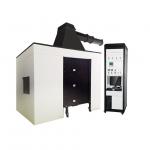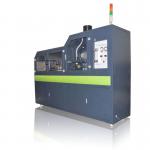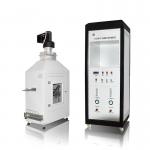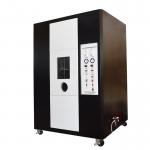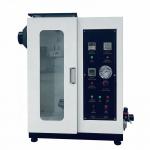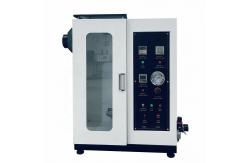In the textile industry and the realm of fire safety, the ASTM
D6413 Textile Vertical Flame Test Chamber, also known as the
Textile Vertical Burning Tester, is a vital instrument. It is
designed to evaluate the flammability and flame resistance of
textiles, providing crucial information for a wide range of
applications. The ASTM D6413 Textile Vertical Flame Test Chamber is a specialized
apparatus used to conduct vertical flame tests on textiles in
accordance with the ASTM D6413 standard. It is essential in textile
manufacturing plants, quality control laboratories, and research
institutions. By subjecting textile samples to a controlled flame
source and measuring parameters such as flame spread rate,
afterflame time, and afterglow time, it determines the ability of
the textile to resist the spread of fire and self-extinguish. This
data is crucial for ensuring the safety of textiles used in
clothing, upholstery, curtains, and other applications where fire
resistance is a key concern. - Robust and Controlled Testing Environment
- The test chamber is constructed from high-quality stainless steel
or other heat-resistant materials. It is designed to have a
well-defined testing area with proper ventilation to ensure the
accurate and reproducible measurement of flame characteristics. The
chamber is equipped with a transparent observation window that
allows operators to monitor the test progress without interfering
with the test conditions. The interior surfaces are smooth and
non-combustible to prevent any unwanted ignition sources or
interference with the textile sample's combustion.
- The sample holder is adjustable and can accommodate different sizes
and shapes of textile samples. It is designed to hold the sample in
a vertical position, ensuring that the flame impinges on the sample
in a consistent manner. The holder is also made from heat-resistant
materials to withstand the high temperatures during the test.
- Precision Flame Generation and Measurement Systems
- The ASTM D6413 tester is equipped with a reliable flame source. The
burner is calibrated to produce a specific flame height and
temperature, typically a methane or butane burner with a controlled
gas flow rate. The flame height can be adjusted accurately to meet
the requirements of the ASTM D6413 standard. The tester also has a
timer and sensor system to measure the afterflame time (the time
the sample continues to burn after the flame source is removed) and
the afterglow time (the time the sample glows without a visible
flame).
- The measurement system is accurate and reliable. The sensors can
detect even small changes in the flame and sample characteristics.
The data acquisition system records all the test parameters,
including flame spread rate (calculated based on the distance the
flame travels along the sample over time), afterflame time, and
afterglow time. It can generate detailed reports, complete with
graphs and charts, that provide a comprehensive analysis of the
textile's flammability performance.
- Safety Features and Compliance
- The test chamber is equipped with multiple safety features. It has
a safety shut-off valve for the gas supply in case of any abnormal
combustion or emergency. The enclosure is designed to contain any
potential flying debris or embers in case the textile sample breaks
apart during the test. The machine also complies with all relevant
safety standards and regulations, ensuring the safety of the
operator and the surrounding environment.
| Test power supply | 220V±10%, 50HZ; total power is 300W | | Combustion gas source | Industrial propane or butane gas (user-owned) | | Specimen fixture | L422 x W89 x H2 mm | | Sample | (L300 x W80) mm, 5 pcs in the radial and latitudinal directions
separately | | Burning torch | Inner diameter φ11mm, tube head and vertical line at 25° angle | | Flame height | 40 ± 2 mm | | Gas pressure (ie, igniter inlet gas pressure) | 17.2kpa ± 1.7kpa | | Flame timer | 99.99 h/min/s arbitrarily set | | Flame retardant timer | 99.99 h/min/s arbitrarily set | | Smoldering timer | 99.99 h/min/s arbitrarily set | | Ignition system | High voltage electronic ignition | | Test machine dimensions | L647 x W350 x H857 mm |
- Accurate Flammability Evaluation
- The primary function of the ASTM D6413 Textile Vertical Flame Test
Chamber is to provide a detailed and accurate assessment of the
flammability of textiles. By precisely measuring the flame spread
rate, afterflame time, and afterglow time, it determines how
quickly a fire can spread on the textile and how well it can
self-extinguish. This information is valuable for comparing
different textile materials and selecting those with better fire
resistance properties. For instance, in the production of
firefighter uniforms or industrial protective clothing, only
textiles that pass strict flammability tests are used to ensure the
safety of the wearer.
- The measurement of these parameters also helps in understanding the
combustion behavior of textiles. It can identify whether a textile
has a tendency to melt, drip, or produce excessive smoke during
combustion, which are all important factors in assessing its
overall fire hazard.
- Compliance with Safety Standards and Regulations
- The textile industry is subject to strict safety standards and
regulations. The ASTM D6413 tester is a reliable tool for ensuring
compliance. It enables textile manufacturers to conduct tests in
accordance with the ASTM D6413 standard and other relevant
international and national safety regulations. By using this
equipment, manufacturers can prove that their products meet the
necessary flammability criteria, facilitating market access and
enhancing consumer confidence.
- Regulatory bodies rely on the accurate test results obtained from
this chamber to enforce safety regulations. It serves as a
dependable means for inspectors and certifying agencies to
determine the suitability of textiles for use in different
applications, ensuring that only those that meet the required
safety levels are approved.
- Research and Development Support
- In the field of textile research and development, the test chamber
is an invaluable asset. It allows textile scientists and engineers
to study the effects of different fiber compositions, fabric
structures, and finishing treatments on the flammability of
textiles. For example, in the development of new flame-retardant
textiles, the chamber can be used to evaluate the effectiveness of
different flame-retardant additives and their impact on the overall
performance of the textile.
- By understanding how various factors influence the flammability of
textiles, researchers can optimize the design and production of
fire-safe textiles. This could involve the selection of more
suitable fibers, the modification of fabric weaving or knitting
techniques, or the development of new and more effective
flame-retardant coatings. The detailed data provided by the ASTM
D6413 test chamber serves as a roadmap for driving innovation and
improving the overall fire safety of textiles.
- Stringent Manufacturing Process
- The ASTM D6413 Textile Vertical Flame Test Chamber is manufactured
under strict quality control procedures. Each component is
carefully sourced and inspected for quality and performance. The
assembly process is carried out by highly trained technicians in a
clean and controlled environment, ensuring the proper alignment and
functionality of all parts.
- The calibration of the burner, sensors, and measurement systems is
a critical and regular part of the manufacturing process. It is
performed using traceable reference standards to guarantee the
accuracy and reproducibility of the test results. Rigorous quality
audits and inspections are conducted at various stages of
production to maintain the highest level of product quality.
- Quality Certification and Validation
Our test chamber has obtained relevant quality certifications and
has been validated by independent testing laboratories. It has been
proven to provide accurate and reliable test results, conforming to
the ASTM D6413 standard and other relevant international and
national safety standards. We also continuously update and improve
our product based on the latest technological advancements and
customer feedback to ensure its long-term performance and
compliance.
- Textile Manufacturing Industry
- A leading textile manufacturer used the ASTM D6413 tester to
develop a new line of flame-retardant upholstery fabrics. The test
results showed that the new fabrics had significantly reduced flame
spread rates and afterflame times compared to their previous
products. This enabled them to market the fabrics as a premium
fire-safe option, meeting the increasing demand for fire-resistant
home furnishings. The company experienced an increase in sales and
enhanced its reputation in the market.
- A producer of technical textiles utilized the equipment to optimize
the performance of their industrial fabrics. By testing different
fiber blends and fabric constructions, they were able to improve
the flame resistance of their fabrics used in applications such as
conveyor belts and filtration systems, reducing the risk of
fire-related accidents in industrial settings.
- Research Institutions
- A research institute focused on textile materials used the ASTM
D6413 Textile Vertical Flame Test Chamber to study the long-term
durability of flame-retardant finishes on textiles. The data
obtained helped them develop new and more durable flame-retardant
treatments that could withstand repeated washing and wear,
contributing to the advancement of textile technology and the
improvement of fire safety in clothing and home textiles.
- Another research institution investigated the effect of
nanotechnology on the flammability of textiles. Their studies led
to the discovery of new nanoparticle-based flame-retardant
additives that could enhance the fire resistance of textiles
without significantly affecting their other properties, opening up
new possibilities for the development of high-performance
flame-retardant textiles.
- Fire Safety and Regulatory Agencies
- Fire safety agencies used the test results from the ASTM D6413
chamber to enforce safety regulations in public spaces. They could
ensure that textiles used in curtains, carpets, and upholstery in
hotels, theaters, and other public buildings met the required
flammability standards, reducing the risk of fire incidents and
protecting the public.
- Regulatory agencies relied on the tester to certify textiles for
different applications. The accurate test data provided by the
chamber enabled them to issue reliable certifications, giving
consumers confidence in the safety of the textiles they purchase.
|
